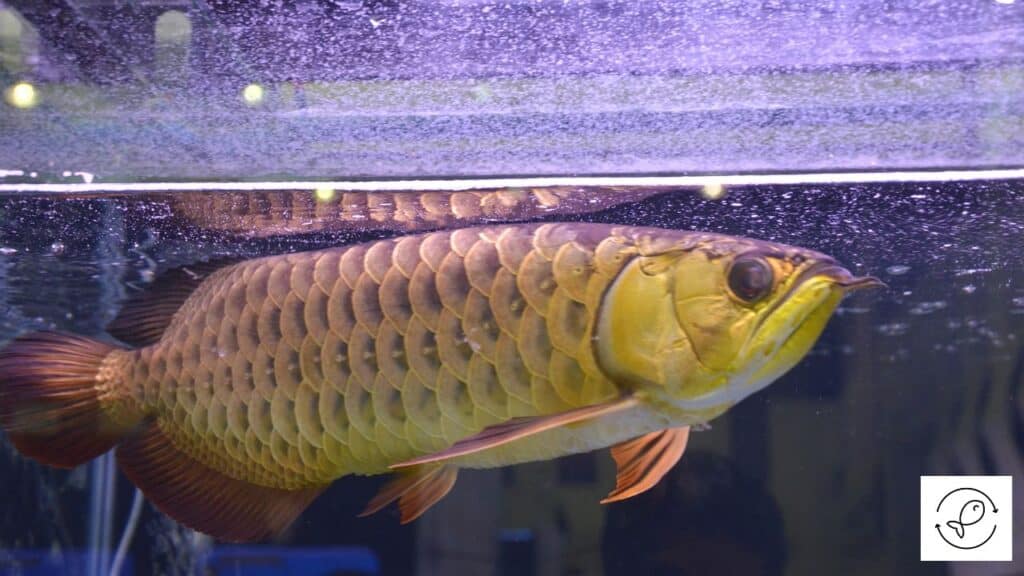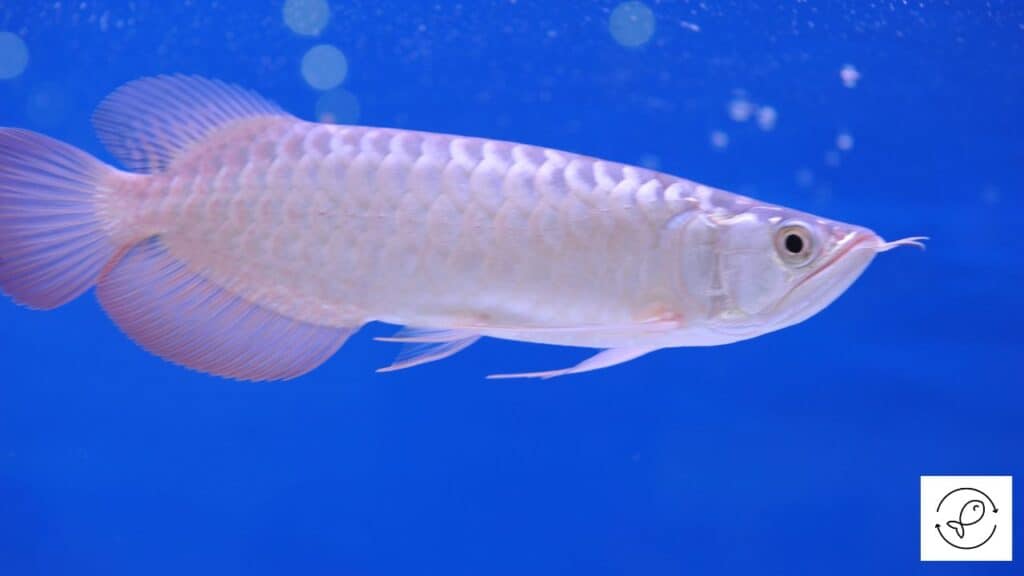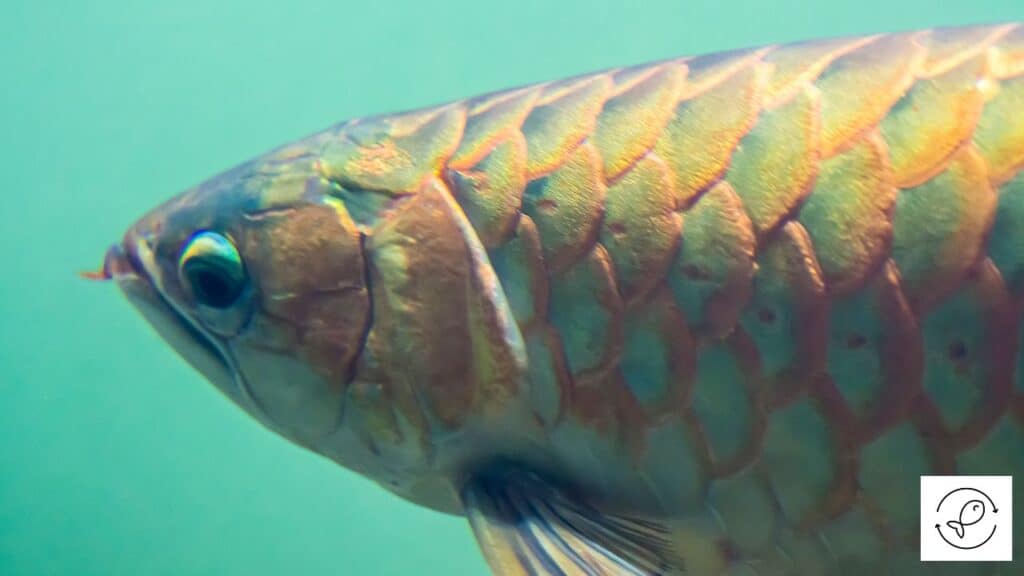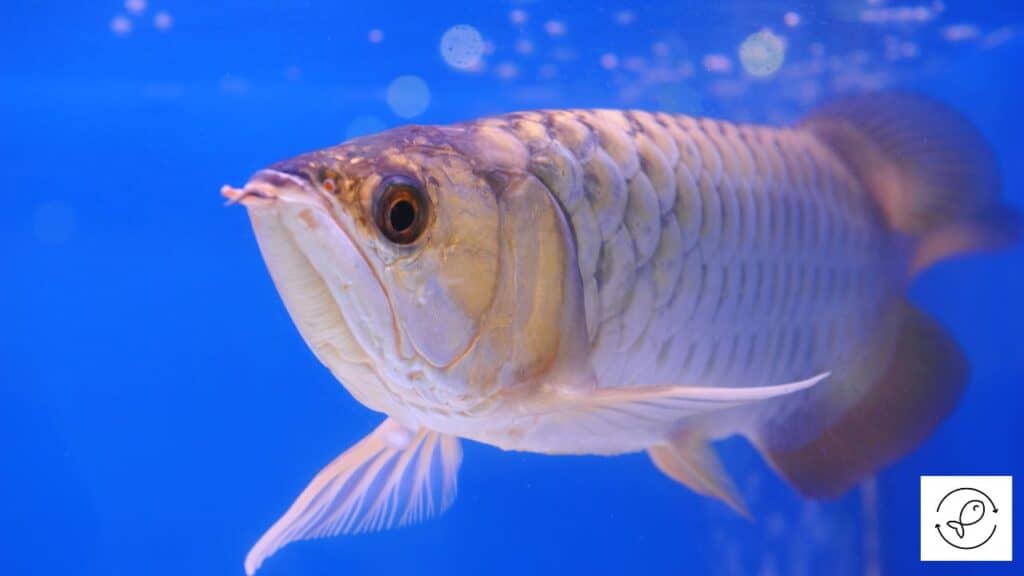Asian arowanas are a popular and highly sought-after freshwater fish species.
Due to their rarity and high price tag, these fish are often considered a status symbol among the wealthy.
Let’s understand this fish species in more detail.
Asian Arowana Species Overview
Asian arowana, scientifically known as Scleropages formosus, is a group of freshwater fish found in various parts of Southeast Asia with different physical characteristics.
They are commonly found in blackwater rivers and slow-moving waters in forested swamps and wetlands.
Asian arowanas have several other common names, including Asian bonytongue, dragonfish, and several names specific to the different color varieties.
These exotic fish are illegal in many countries since they are endangered. They are also rare due to trade restrictions.
The decline of the Asian arowana population in their natural habitats is attributed to over-fishing and the destruction of their environment.
Scientific Classification
Kingdom: Animalia
Phylum: Chordata
Class: Actinopterygii
Order: Osteoglossiformes
Family: Osteoglossidae
Genus: Scleropages
Scientific Name: Scleropages formosus
Appearance

Asian arowanas are large, elongated fish with a distinctive appearance.
These fish have long anal, pectoral, and pelvic fins that match their body length. However, the dorsal fin is short and smooth.
Asian arowanas have large scales that are iridescent and shimmer in the light, giving them a metallic sheen.
The color of their scales ranges from silver to deep red, while the back is typically black.
Different color variations of Asian arowanas exist due to geographical adaptations.
Asian arowanas are considered a symbol of good fortune in Chinese culture due to their scale’s resemblance to coins.
Lifespan
Asian arowanas are a long-living species with an average lifespan of 15 years or more in captivity.
Factors such as water quality and diet can impact the lifespan of this species.
So it’s crucial to ensure that they get optimal conditions in aquariums for their longevity.
Due to the high demand for Asian arowanas in the exotic fish pet trade, it’s difficult to determine their lifespan in their natural habitat.
Average Size
Asian arowanas are large fish that can grow up to 3 feet (36 inches) in length.
The size of these species indicates their health and well-being, with larger fish being considered healthier.
Their growth and size also depend on genetics, food, water parameters, tank size, and other environmental conditions.
Asian Arowana Tank Setup

Asian arowanas are large and active fish. They need a well-maintained tank with plenty of swimming space.
Establishing a balanced ecosystem that mimics their natural habitat is crucial for the well-being of these fish.
Let’s understand the tank requirements of Asian arowanas in more detail.
Tank Size
Asian arowanas need a large tank for optimal health and survival. They grow pretty large, up to 3 feet.
So a spacious tank with ample swimming space is essential for their optimal growth.
A minimum tank size of 250 gallons is recommended for one adult arowana.
Young Asian arowanas can be raised in a 60-gallon tank.
But it’s essential to transfer them to a large tank as they grow to avoid deformities and premature demise due to space shortage.
The larger the tank, the better it’s for the fish.
A larger tank provides more swimming space and reduces the stress levels of these fish.
A large tank is also easier to maintain since it’s less affected by fluctuations in water conditions.
Tank Equipment and Decorations
When setting up a tank for Asian arowanas, it’s vital to have the right equipment.
A robust filtration system is necessary to maintain good water quality.
The filter should be able to handle a large volume of water and should be cleaned regularly to prevent the buildup of harmful toxins.
The tank should also have a heater to maintain a constant water temperature and a digital thermometer to monitor the water temperature.
Proper lighting can enhance the colors of arowanas.
Moreover, Asian arowanas are large fish and need plenty of swimming space.
So it’s advisable to keep the decorations in the tank to a minimum.
A few large rocks, driftwood, and aquatic plants can be added to create a natural-looking environment for the fish.
It’s also important to ensure that the decorations don’t obstruct their swimming space or harm them.
Asian arowanas are powerful swimmers. So any item that you place in the tank should be sturdy.
Another thing to remember is that these fish are jumpers.
So it’s advisable to have a tight-fitting lid on the tank to prevent them from jumping out.
Given below are the items that you should keep in an Asian arowana tank:
- Substrate (fine gravel or sand),
- Aquarium Filters,
- Aquarium Heater,
- Adequate Lighting,
- Aquatic plants like Amazon Swords,
- Thermometer,
- pH testing kit, and
- Decorations such as rocks, driftwood, caves, etc.
Asian Arowana Care

Asian arowanas are prone to stress if they aren’t cared for properly.
So adequate attention and care are essential for them to thrive.
Let’s learn more about how to take care of Asian arowanas.
Diet
Asian arowanas are predatory fish that enjoy feeding on small fish, frogs, snails, insects, invertebrates, frogs, snakes, and small rabbits in their natural habitat.
Feeding them a diet mimicking their natural feeding habits is essential to keep them healthy.
These fish have an insatiable appetite for live food. So protein-rich foods should be offered to them as primary food sources.
You can feed Asian arowanas live and frozen foods to satiate their dietary requirements.
Some of the live food that you can feed Asian arowanas are:
- Bloodworms,
- Scorpions,
- Mealworms,
- Crabs,
- Crickets,
- Insects and their larvae,
- Krills,
- Earthworms,
- Small frogs,
- Feeder fish, etc.
Feeding them small amounts of food multiple times a day is advisable.
This will prevent overeating and keep them healthy.
Young arowanas should be fed twice daily with quality food to keep up with their rapid growth rate.
As they grow, their growth slows down, and they can be fed once daily.
Water Parameters
Asian arowanas live in warm, soft, and acidic water in their natural environment.
So it’s important to replicate their natural habitat water conditions for optimal growth.
Arowanas are also sensitive to water quality. So regular water changes and a robust filtration system are essential.
The ideal water parameters for Asian arowanas are:
Water Temperature: 75°F to 86°F (23.8°C to 30°C),
Water pH: 6.0 to 7.5,
Water Hardness (dGH): 2 to 8.
Tank Maintenance
Regular tank maintenance is essential for the healthy development of Asian arowanas.
It’s essential to maintain good water quality through regular water changes.
This helps in reducing the buildup of toxins and keeps the fish healthy.
When performing a water change, use a siphon to remove debris from the substrate.
Prompt removal of unconsumed food is vital to prevent water contamination.
A filtration system is also essential for ensuring the cleanliness of the water in the tank.
Proper tank maintenance involves the regular cleaning of aquarium filters, substrate, and decorations.
Finally, the water parameters such as pH, ammonia, nitrite, and nitrate levels should be monitored periodically using a testing kit.
Common Diseases
Like all fish, Asian arowanas are susceptible to a range of diseases.
They can be adversely affected by water quality changes, which can rapidly impact their health.
Given below are some of the common diseases that can affect Asian arowanas:
- Fin and Tail Rot,
- Ich,
- Hemorrhagic Disease,
- Fish Ice,
- Dropsy,
- Bacterial infection,
- Fungal infection, and
- Protruding Anus.
Maintaining good water quality and hygiene in the tank is vital to prevent diseases in Asian arowanas.
If your arowana does become sick, prompt treatment with medication and isolation from other fish is necessary.
Asian Arowana Behavior and Temperament
Asian arowanas are known for their solitary nature.
They are usually found alone or in small groups in the wild.
Keeping them alone or with compatible tank mates that can withstand their aggression is best in captivity.
They are territorial fish and can become aggressive toward other fish in the tank, especially while defending their territory.
These fish are also known for their jumping ability and can jump out of the aquarium if the lid isn’t secure.
Another unique behavior of Asian arowanas is their distinct respiratory ability.
Apart from breathing from gills, they can also take air from the surface, enabling them to survive in oxygen-poor water.
Unlike other arowana species, Asian arowanas need little food to maintain good health.
Overfeeding them can result in reduced appetite, shortened lifespan, and compromised breeding.
Asian Arowana Tank Mates

Asian arowanas are predatory fish. Hence, finding suitable tank mates for them is a daunting task.
It’s also necessary to have a secure habitat for young Asian arowanas since they are susceptible to attacks from larger fish.
Asian arowanas are best suited to be tank mates with other Asian arowanas, provided they were raised together.
If you are keeping them with other fish, choose larger tank mates with similar environmental requirements.
Given below are some of the compatible tank mates that you can keep with Asian arowanas:
- Oscars,
- Green Terror Cichlids,
- Parrot cichlids,
- Knife fish,
- Angelfish,
- Catfish species,
- Large plecos, etc.
It’s not recommended to house Asian arowanas with smaller and more peaceful fish because arowanas may view them as prey.
Here are some tank mates to avoid keeping with silver arowanas:
It’s important to remember that Asian arowanas are large fish that need ample space to swim and thrive.
So while choosing tank mates for them, keep their size and temperament in mind.
Asian Arowana Breeding
Breeding Asian arowanas in captivity is challenging.
They breed only in their natural habitat or fish farms that mimic their natural environment.
Asian arowanas mature at a late age, when they are about 3 to 4 years old.
Female Asian arowanas typically lay eggs during the flood season in their natural habitat, usually between December and January.
The breeding process begins with the building of a nest by the couple, followed by the deposition of eggs by the female Asian arowana.
A female arowana lays around 10 to 100 eggs per breeding season. The eggs are relatively large and have a reddish-orange hue.
Asian arowanas are mouthbrooders. The male arowana carries the eggs in his mouth until they hatch.
After the eggs hatch, the male Asian arowana protects the fry for approximately two months or until they can live independently after fully absorbing the yolk sac.
Once the fry become self-reliant, they leave their parents and swim away.
The baby Asian arowanas seek shelter among aquatic vegetation, where they forage for their sustenance.

